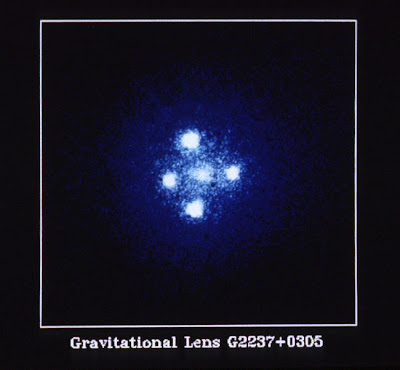First I need to make sure you understand how a traditional glass lens works. Light hits a piece of curved glass and changes angles as it hits the glass and then again as it leaves. The steeper the angle relative to the direction the light travels the more it bends. So it bends more at the edge of the lens than at the middle. Properly formed the light all converges at one point.

The drawing should just give you a general impression, not be assumed to be an accurate guide.
But there are other things that a lens can be made of. At one point there were microscopes that used droplets of water for a lens. But today I'm thinking primarily of black holes.
Black holes are gravitational wells powerful enough to prevent light from escaping. Perhaps I should rephrase that.
Everything made of matter has gravity. You, me, moons, planets, stars, everything.
The moon pulls the water in the oceans making tides.
Earth pulls on the moon preventing the moon from traveling in a straight line. Instead that line gets wrapped around the Earth in an orbit. When an object is big enough to have things orbit it we say it has a gravitational well. It may apply to small things like apples but it's usually only used on massive scale such as planets, stars, and black holes.
That's the easy stuff. What is hard to believe is that even light has mass and gravity. So even light is influenced by the pull of gravity.
A black hole is what you get when a star dies and it's own gravitational pull smashes it to a point so small that the gravitational pull of that mass is strong enough to pull in light and keep it from escaping. Before it dies the mass is so spread out over the whole star that the whole doesn't have enough pull to keep the light from escaping. At least three times the size of our own sun.
So there's all this area around the black hole that can bend the course of light without capturing it.
So, finally, back to gravitational lensing.

Picture a distant galaxy. Now picture Earth. Between there and here there's a healthy sized black hole. Now, obviously any light from that galaxy heading towards us is going to have a black hole in the way and can't get here. But around the black hole the light bends. At a certain distance the light will get bent to shoot off toward Earth. If we're all lined up perfectly the galaxy would appear as a ring around nothing. Offset the galaxy from that line just a bit and it appears as a crescent in the heavens. Probably several.
I've been putting all the weight, so to speak, on black holes and I shouldn't have. Any sufficiently large gravitational well will work. Such as a galaxy.
I don't feel that I've explained things properly but I'm not sure what else to say. So instead you get pictures.
 |
 |
 |
The gravitational flare known as Einstein's Cross. It's a quasar that is being lensed by a galaxy. The quasar is 8 billion light years away. The galaxy is only 400 million. |
I also recommend listening to episode 37 of Astronomy Cast.
http://www.astronomycast.com/astronomy/episode-37-gravitational-lensing/
Feel free to leave questions or clarifications in the comments.
[afterthought: In the cases where you see multiple images of a the object being viewed the different images aren't necessarily the same age. Astronomers like to say they're looking backwards in time when they look into the sky. In a way they are. Since it takes 8 minutes for light to reach us from the sun you're seeing what happened 8 minutes ago instead of what's happening now.
When you're looking at multiple images of something like the quasar in Einstein's Cross the light took 4 different paths around the galaxy. Even a small galaxy isn't something minor to navigate around. So the light from the quasar on the far left is likely to be many centuries younger than the light from the quasar on the far right even though they're both the same quasar.]
1 comment:
What about Hawkings' discovery in 1974 (called Hawking Radiation)? If the negative gravitational forces causes no radiation (light) to get through... then how could Hawkings be right?
How does the magnetic field of the moon and the opposite magnetic field of the earth effect the moon's orbit? Wouldn't it have the same effect as two magnets that are opposite of each other?
How does the gravitational pull of the moon effect the stability of the polar ice caps?
Was the black hole caused by an implosion or explosion of the surface of the star that caused it?
Post a Comment